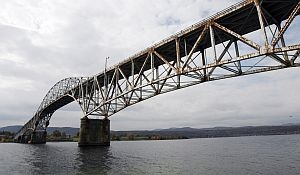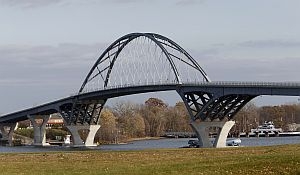 (Host)
(Host)
At the recent opening of the new Lake Champlain Bridge, one observer
got the jump on everyone with a daring sprint across the bridge.
Commentator and Lake Champlain Maritime Museum co-director Adam Kane
thinks that was a good beginning.
(Kane) One recent morning I
announced to my five- and seven-year-old children, "Today, I get to
drive over the new Lake Champlain Bridge for the first time." My
statement was met with quizzical stares, quickly followed by a
discussion of what was for breakfast. They clearly are still too young
to yearn for a place in history. But I was excited at the prospect of
going over the new bridge.
I also felt a little guilty that in the gleam of the new span, I had so quickly moved on from mourning the old bridge.
As
an archaeologist, I function in a world where, by and large, old things
have value. They tell us stories about the past, which help us
understand the present. And wonderfully, we live in a state with an
historic environment and archaeological record rivaling any other place
in the country. Of our historic objects, the 1929 Champlain Bridge was
among the most significant.
 A technological marvel of its day,
A technological marvel of its day,
it was one of the first continuous truss bridges built in the country.
Its graceful transition from the approach spans to the truss was
subsequently adopted in many bridge designs across the nation. It was
also designed to fit into the landscape. The sweeping arches and
graceful form enhanced the stunning mountain and lake backdrop.
And
there were countless human stories. The opening was attended by then
New York Governor Franklin Roosevelt and Vermont Governor John Weeks. On
opening day, towns across Vermont and northern New York sent elaborate
floats, which contributed to a traffic jam throughout Addison County,
the likes of which we have yet to see again.
More than a few
strange things happened on the bridge, like the seizure of $20,000 worth
of contraband liquor in 1933. Or the 1945 robbery of the toll keeper by
three teenagers, which was considered to be "one of the region’s most
flagrant cases of juvenile crime on record." The 1970s saw – what else? –
two streakers running across the bridge. And the bridge’s 2000 cameo
with Harrison Ford in What Lies Beneath was memorable, even if the movie
wasn’t.
 In December 2009, I watched as the detonation so
In December 2009, I watched as the detonation so
quickly took down this landmark. Now, two years later, driving the old
route over the new bridge, a few things stand out. The new pitch isn’t
quite as steep as the old, and the thud-thud which used to accompany a
vehicle’s transition from the approach onto the bridge deck is now gone.
But the bridge itself and the view from the top are as glorious as
ever.
Yes, the 1929 bridge was a landmark, but the 2011 span
appears to be following its lead. First among its stories is the sprint
of 11-year-old Harrison Rich of Moriah, New York. He stole the thunder
of the dignitaries at the opening by galloping first across the bridge.
Now there’s someone who appreciates a chance to get a place in history.
He might not be FDR, but you have to start somewhere.